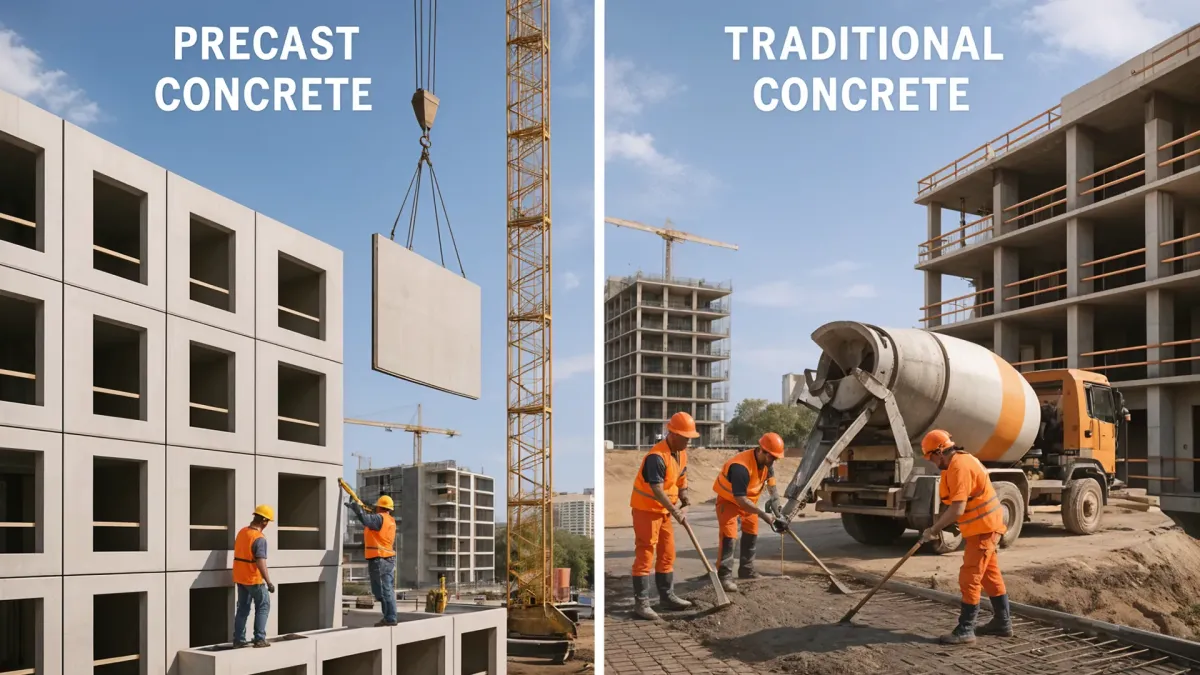
Precast vs. Traditional Concrete: What Builders Really Need to Know
Construction delays. Poor finishing. Endless site headaches. Is that a familiar story? Most builders have been there. You plan everything down to the last nail, and yet, something as basic as pouring concrete can throw the whole schedule off. Rain hits. Labour does not show. The mix was not right. And suddenly, you're bleeding time and money.
That's the reality of traditional concrete. It's built on-site, shaped on-site, and carries all the chaos that comes with it.
But there's another way the industry is leaning into—one that trades uncertainty for control. And that's where precast concrete enters the story.
Before we weigh both sides, let's lay the groundwork on what they really are.
The Basics: Two Methods, Two Mindsets
Traditional concrete is poured and set on-site. Everything—mixing, curing, shaping—happens right there at the job. It's flexible but messy. It's familiar but unpredictable. Most builders are used to it because it's what they've always known. But that doesn't mean it's the best fit for every project.
Precast concrete, on the other hand, is made in a factory under tight control. The components show up at your site ready to install. It is like assembling a structure, not building it from scratch. You gain speed, quality, and predictability.
That shift in process changes everything—especially how your project moves forward.
Time: Where Precast Gains the Edge
Nobody likes idle teams or delayed payments. But that's exactly what traditional concrete invites when site conditions aren't in your favour. One storm? You're pushed back a week. And that's not counting issues like last-minute design changes or supplier delays.
With precast concrete, you're working on two tracks. While one team gets the site ready, the structural components are already in the making. That means fewer gaps, faster installation, and a project that actually stays on schedule.
You're not just saving time—you're gaining control over the timeline. You can commit to deadlines and actually meet them.
When your build runs like clockwork, your bottom line thanks you.
Quality Shouldn't Be a Gamble
We all know how much guesswork can go into site mixes. One bad batch of traditional concrete, and you're staring at cracks in three months. And no builder wants that conversation with a client.
The precast concrete industry doesn't play that game. Every element is made under consistent conditions. Same materials. Same curing process. Same finish. You know what you're getting. And it shows up on-site exactly as expected.
Plus, you can integrate high-performance concrete mixes like UHPC right at the production level. That means longer lifespans and lower maintenance.
No more praying the site mix holds up. No more patch-ups before the handover.
Labour & Safety: Less Risk, Less Guesswork
Coordinating large labour teams on-site is tough, especially when skilled hands are in short supply. And with traditional concrete, you're depending on them for every pour, every day. That leaves room for inconsistency and delays.
Precast concrete simplifies things. Most of the heavy lifting happens off-site, so you reduce your need for on-ground manpower. Safer, smoother, and far more efficient. It also reduces risk exposure—fewer people, fewer problems.
Less crowd. Less chaos. Better focus where it matters.
Cost: The Budget Breakdown That Truly Makes Sense
It's easy to think precast concrete is expensive. Yes, it might cost more upfront. But think beyond that.
Fewer delays. Less labour. Reduced rework. Shorter project timelines. Those all add up to serious savings. Traditional concrete may look cheaper on Day 1, but by Day 100? Not so much.
Also, with precast, material estimation is more precise. You don't overorder. You don't deal with as many site losses. And over time, that precision leads to better financial planning.
Smart budgets don't just chase low numbers. They look at where the money's going—and staying.
Sustainability: Building Clean. Building Consciously
Sites using traditional concrete often face material spills, cement wastage, and messy leftovers. All that waste isn't just bad for the planet—it's money out the door.
The precast concrete industry takes a more streamlined approach. Materials are batched precisely. Water gets reused. Scraps get repurposed. You cut down on dust, noise, and disposal costs in one go.
And that's not just good optics—it's fast becoming a requirement in future-focused cities and green-certified buildings.
Clean work isn't just for aesthetics. It's smarter, greener, and more efficient.
Complex Designs? Precast Is All In
Some think precast concrete limits creativity. The truth? It opens up new doors. Curved panels, textured finishes, intricate facades—you can plan and produce them all in advance.
With traditional concrete, every design tweak slows you down. Rework gets messy. Labor costs rise. With precast, design and precision go hand-in-hand. You get bold forms without slowdowns or on-site rework.
Architects love it. Builders appreciate the predictability. And clients? They get wowed by the finish.
When creativity meets control, great architecture happens faster.
It's Not A One-Size-Fits-All. So Which One Fits Where?
Not every project needs to go all-in on precast concrete. Sometimes, traditional concrete makes sense—small plots, simple shapes, or remote sites. Especially where access is limited or transportation adds complications.
But for infrastructure, modular buildings, large-scale developments, or time-sensitive builds, precast takes the win.
The smartest approach? A mix of both. Know when to switch, when to blend, and when to rethink old habits.
The best builders don't pick sides. They pick what works.
Final Take: Think Ahead, Build Smarter
Precast concrete isn't a trend. It's a smarter way to build. The precast concrete industry is growing for a reason—it brings speed, consistency, and efficiency to the table. It answers today's demand for faster timelines, cleaner sites, better finishes, and stronger results.
So the next time you're planning a project, ask yourself: do you want to pour and pray? Or plan and place?
Either way, the concrete you choose today sets the pace for everything that follows tomorrow.
